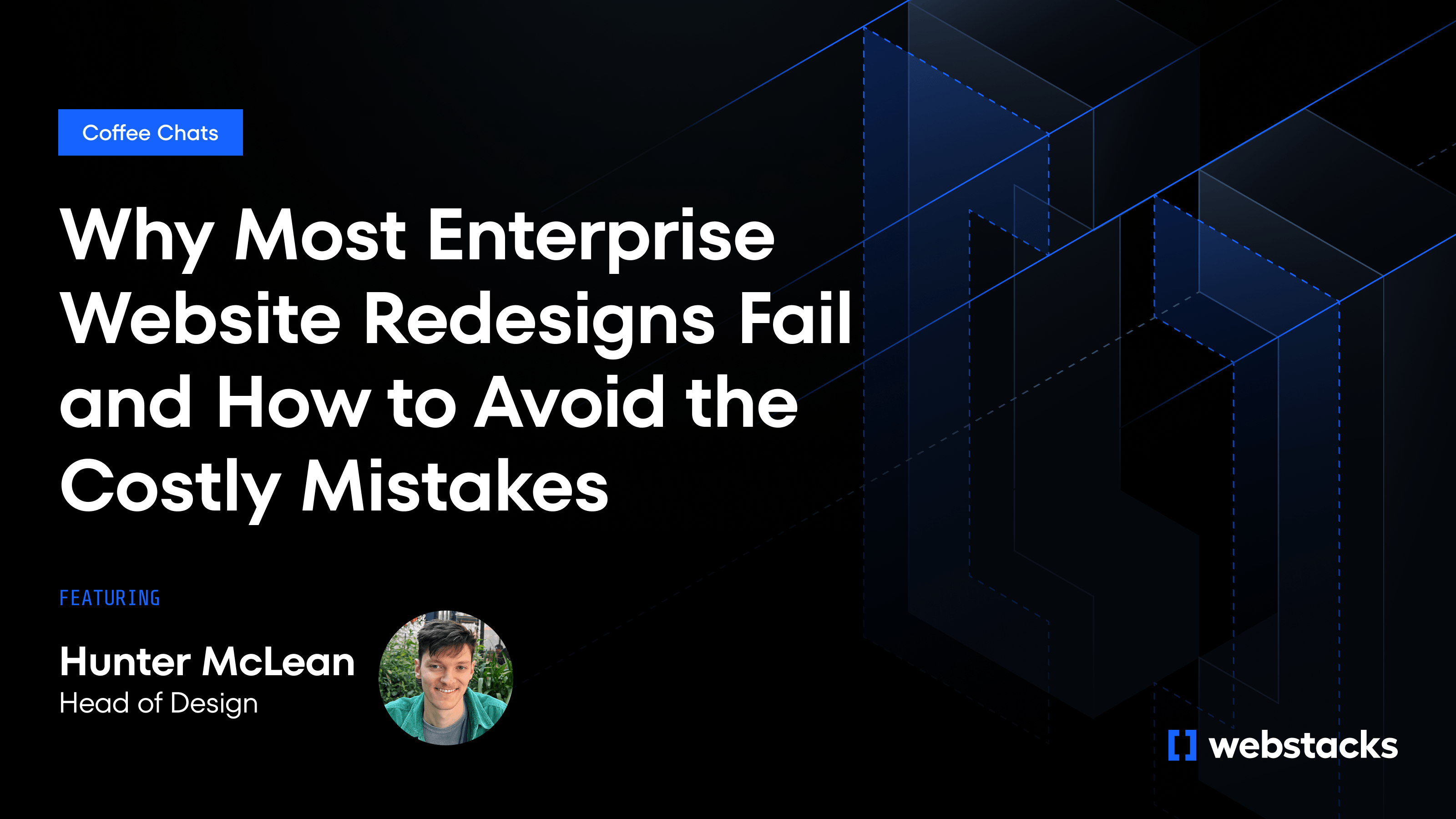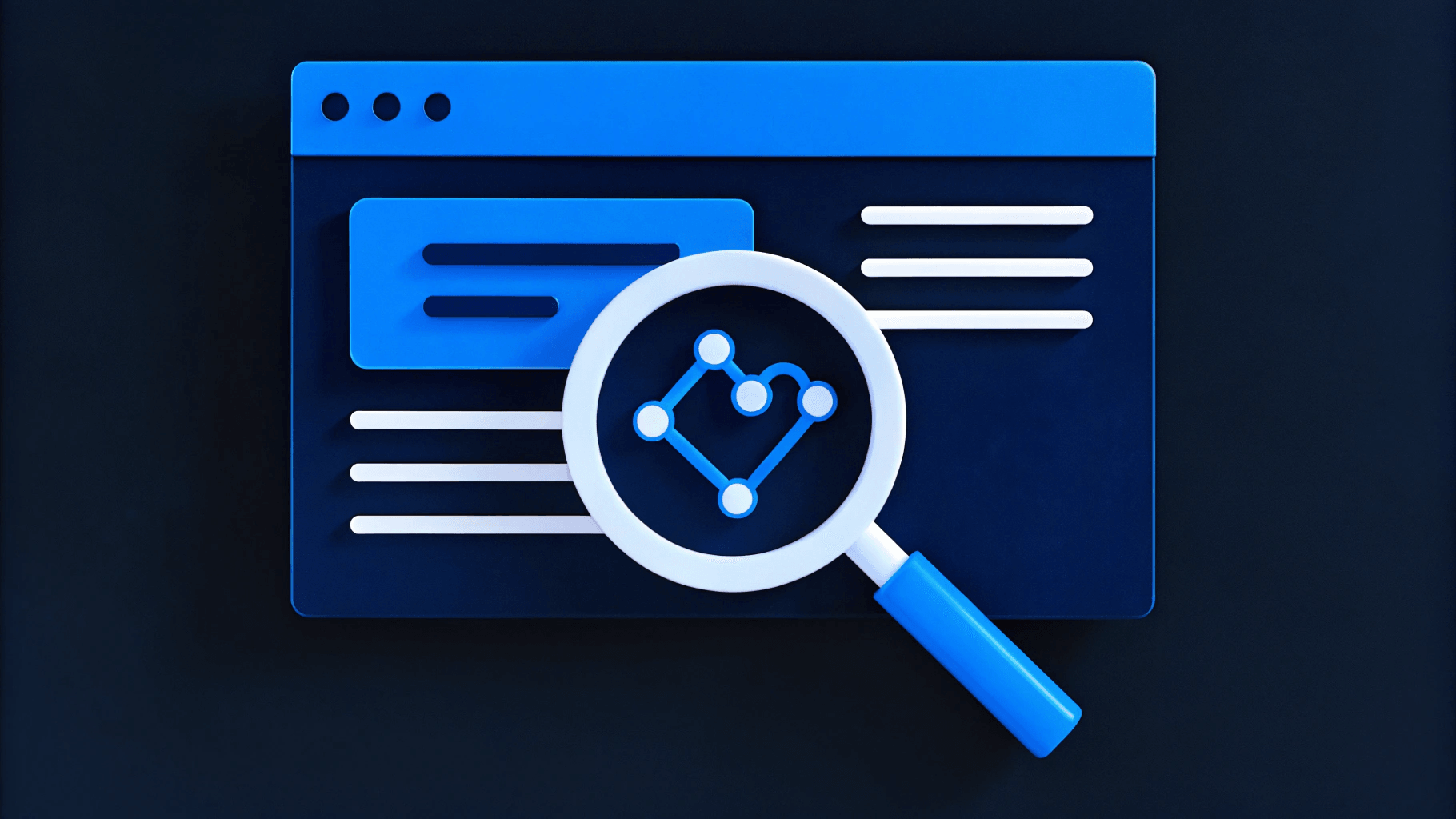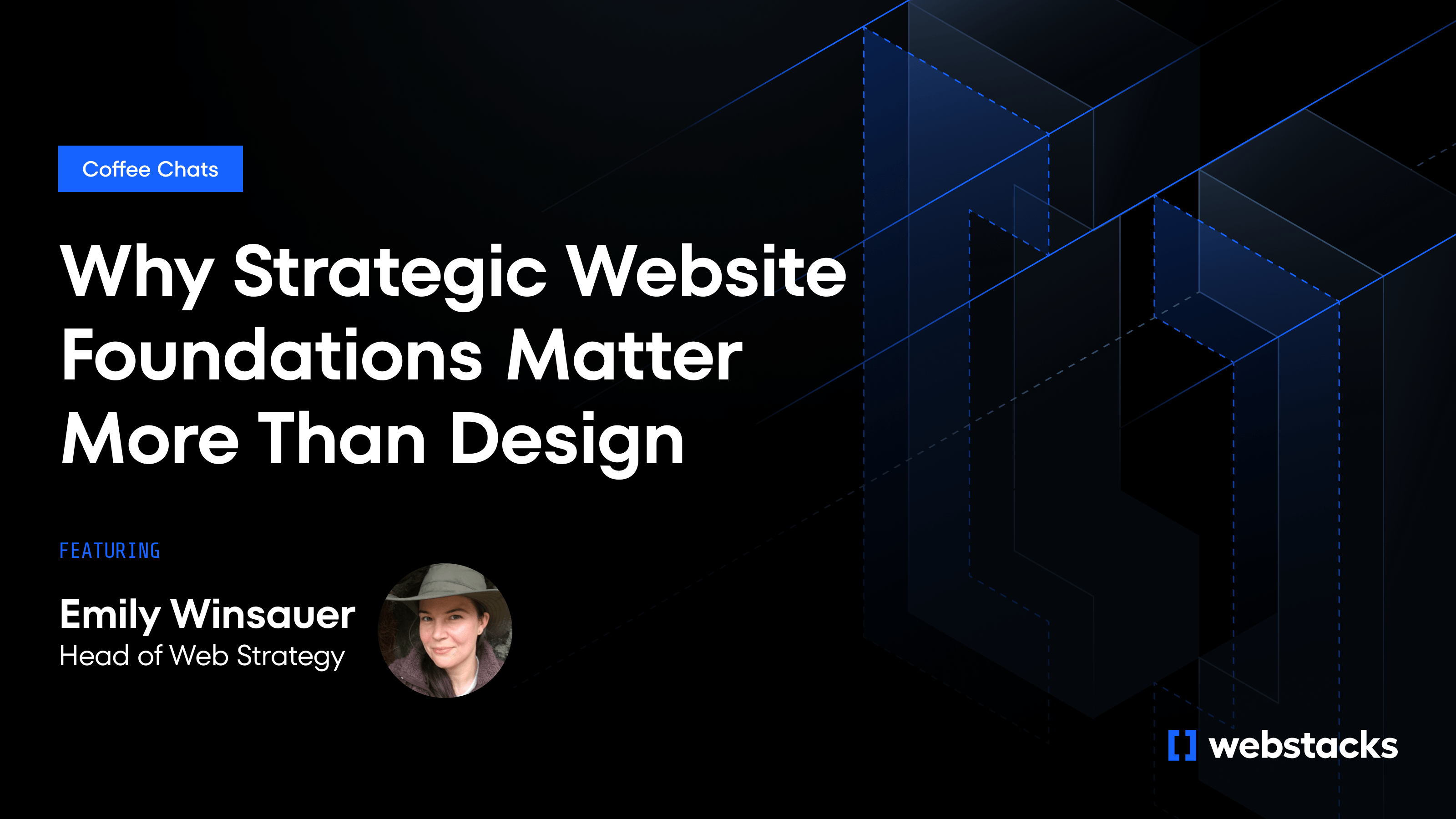The hidden complexities, process breakdowns, and relationship failures that derail enterprise web projects, and what B2B marketing leaders should demand from their agency partners.
I recently sat down with Hunter McLean, our Creative Director, to answer a question that's been on my mind: why do so many enterprise website redesigns miss the mark? With projects like Gong's Phase 1 recently under our belt, I wanted to understand what makes enterprise web work fundamentally different and why the approach that works for a 10-page startup site will absolutely fail for a company with decades of brand equity, 30+ pages, and multiple teams depending on the website to drive pipeline.
What Hunter revealed wasn't just about design or development. It was about the strategic, operational, and relational complexities that most agencies either don't understand or aren't equipped to handle.
Enterprise Sites Are Operationally Different, Not Just Bigger
When I asked Hunter how we define an enterprise website, his answer cut straight to what actually matters: "Enterprise sites typically have 30 plus pages, and that's definitely more than most. But it's not just about page count. It's about how many people are using the website."
The problem most agencies miss is this: enterprise companies have more content marketers, more product marketers, more stakeholders with competing priorities. Your website isn't managed by one CMO or a marketing generalist. It's a cross-functional system that has to serve demand gen, product marketing, sales enablement, regional teams, and sometimes customer success.
If your agency's first question is "What do you want your homepage to look like?" instead of "Who uses this site, and what are their workflows?" they're approaching your project with a startup mindset.
For startups, the goal is speed: get 10 pages live, establish the brand, move fast. For enterprise clients, the goal is scalability and flexibility across a much larger operation that's already established, already generating revenue, and already constrained by legacy systems and past decisions.
Questions your agency should be asking during scoping:
- How will you account for the different teams that manage and use our website?
- What systems will you put in place to prevent bottlenecks when multiple stakeholders need to publish simultaneously?
- How will your design system support both strategic brand initiatives and performance marketing execution?
Why Discovery Has to Go Deeper for Enterprise Clients
One of the biggest shifts in our process for enterprise clients happens during discovery. With startups, their current site is usually our starting point because there's not much history to unpack. But with enterprise clients, we're looking back years to understand the evolution of their brand and website.
Hunter walked me through the approach: "I looked back five years of their homepage and just saw the transformation. We asked: what were those decisions all about? Why did you reach those points? How did you get to where you are today?"
This historical research isn't just for context. It's critical to avoiding wasted effort. Enterprise clients have already tested things, built components, and made strategic pivots. Understanding what worked, what didn't, and why helps us avoid pitching ideas they've already tried and ruled out.
There's also brand equity to protect. Hunter gave me a perfect example from Gong: "They said, 'This was our brand from day one. People know us because of this aspect. We want to retain this very small detail that we probably would have never known unless we learned more about their past.'"
With startups, you can afford to be more experimental because there's less history and less brand equity at stake. But with enterprise clients, you're navigating years of accumulated decisions, and a good agency should treat that as an asset, not an obstacle.
Enterprise Problems Are Architecturally Complex, Not Just Bigger
Hunter made an observation that stuck with me: "Enterprise clients know what they want. They're not figuring it out as they go. But the problems they need us to solve are far more complex."
A startup might come to us and say, "We need a blog page with 100 posts." Simple, standard work. An enterprise client says, "We have thousands of articles and resources. We need to structure a resource hub with advanced filtering, search, tagging, and a content model that supports multiple content types across different buyer personas and funnel stages." That's not a "bigger" version of the same problem. It's a different problem entirely.
Hunter gave me another example from Cribl, where the challenge wasn't just "add a demo page." It was figuring out how to embed interactive product demos on the site without destroying performance, while ensuring the experience worked across devices and integrated seamlessly with their product data.
If your agency doesn't ask detailed questions about your content strategy, your martech stack, your user journeys, and your internal workflows during discovery, they don't understand the scope of what they're building.
Red flags to watch for:
- Generic proposals that could apply to any company in your industry
- Agencies that jump straight to design concepts without asking about your content model or CMS governance
- Timeline estimates that feel unrealistically fast for the complexity of your site
Design Systems That Work in Practice, Not Just in Figma
Hunter reinforced something I've seen play out on multiple projects: "When we're building enterprise systems, scalability and flexibility are non-negotiable. We need to know how quick their iteration cycles are and how many people are going to have a take on switching things up."
Most agencies build a design system that works great for the launch but breaks down the moment your team tries to use it. Why? Because they designed it for their workflow, not yours.
Hunter explained how we avoid this: "We're building components that have content models that support every use case across their current site and what we're going to build. We need to think about what pages are going to be migrated and what components and structure we have that's going to match their migration pages, so nothing falls through the cracks."
Your design system isn't just a visual style guide. It's an operational tool that has to support multiple teams with different skill levels and use cases. The system has to be intuitive enough for non-technical users while still giving developers the flexibility to build advanced functionality when needed.
Questions to ask your agency:
- How will you ensure non-technical users can build pages without developer support?
- What training and documentation will you provide for our team?
- How will the system accommodate both strategic brand work and rapid campaign execution?
- What happens when we need to add a new component type six months after launch?
Why Phased Launches Are the Standard for Enterprise Projects
Hunter explained why we almost always recommend phased launches for enterprise clients: "If we didn't do phased approaches, we would end up in a realm where we spend six months on a project, we launch it, and the goals when we started six months ago have shifted."
Enterprise companies operate on quarterly cycles. Priorities shift. New products launch. Market conditions change. A six-month waterfall project would be outdated by the time it went live. Phased launches solve this by letting you tackle things in the moment, achieve goals incrementally, and pivot based on real data, not assumptions you made six months ago.
Hunter broke down what this looks like: "Phase 1 is about the basics: building the design system, redesigning critical pages, establishing the foundational components. Phase 2 is where we get into the bells and whistles: advanced functionality, content-specific components, more experimental interactions."
A phased approach isn't about doing less work. It's about doing the right work at the right time and building in feedback loops so you're not locked into decisions that no longer serve your business.
Questions to ask your agency:
- How do you recommend we phase this project, and why?
- What metrics will we use to evaluate Phase 1 before moving to Phase 2?
- How do you handle scope changes between phases as our priorities evolve?
Enterprise Clients Use Inspiration Differently
I've noticed everyone references the same sites when discussing design inspiration: Stripe, Linear, Notion. But I wanted to know if enterprise clients fall into the same trap of trying to look like someone else instead of doubling down on their own identity.
Hunter's answer clarified an important distinction: "Enterprise clients still reference big-dog sites like Stripe, but not for branding. They reference them for functionality and interaction patterns. On the branding side, they're their own inspiration."
Startups are often still figuring out their brand identity, so they want to emulate what's working elsewhere. But enterprise clients already know who they are. They've built brand equity over years, and their audience recognizes them for specific qualities.
The mistake agencies make is treating enterprise redesigns like rebrands where they try to "modernize" the brand by making it look like everyone else.
Hunter shared an example from Gong: "They knew who they were, they loved who they were, and our challenge was how do we mature the brand but also 'Gongify' it. They wanted it to be very Gong. They are their own inspiration."
Your redesign shouldn't make people say, "Wow, that looks like [insert trendy SaaS site]." It should make them say, "That feels exactly like [your brand], but better."
Why Relationship Dynamics Determine Long-Term Success
The best enterprise redesigns aren't transactional. They're collaborative partnerships where both teams bring complementary expertise to the table.
Hunter put it perfectly: "You have to be a little bit of a chameleon at first to make sure you're building a relationship where clients feel open, where they view you as a knowledgeable expert they can trust and rely on. A lot of that goes into making sure people feel heard."
If your agency doesn't feel like an extension of your team during the project, they won't be after it either. That means you'll lose the institutional knowledge, strategic continuity, and ongoing optimization that make enterprise sites successful over time.
What Enterprise Marketing Leaders Should Demand
After this conversation with Hunter, I walked away with a clearer understanding of what separates agencies that say they do enterprise work from agencies that actually deliver on it.
Here's what you should demand:
✓ Deep discovery that includes brand history, past decisions, and stakeholder workflows
✓ A design system built for scalability and multiple users (not just a visual style guide that breaks down in practice)
✓ A phased approach that aligns with your business cadence
✓ Strategic POV on your brand identity (not a proposal to make you look like every other SaaS site)
✓ A collaborative partnership mentality: Demand that your agency treat your enterprise redesign like the complex, high-stakes, operationally critical project it actually is. When you get it right, your website stops being a constraint and starts being a scalable growth engine.
Work with Webstacks to build a website that scales with your business.




